Renaissance - Simple English Wikipedia, the free encyclopedia

The Renaissance is a period in European history that followed the Middle Ages and ended in the 17th century. “Renaissance” is a French word for “cultural rebirth.” During this period, there was a “rebirth” of classical learning. People started relearning the teachings of scholars from Ancient Greece, Rome, and other ancient societies. The Renaissance is often said to be the start of the "modern age"
During the Renaissance, there were many advances in art, literature, the sciences, mathematics, and culture. Many famous artists, writers, philosophers, and scientists lived during this period. A person who is clever at a great number of things is sometimes called a "Renaissance man". The most famous Renaissance man is Leonardo da Vinci, who was a painter, a scientist, a musician and a philosopher.
The Renaissance started in Italy, but soon spread across the whole of Europe. In Italy, the period is divided into three parts:
- the Early Renaissance
- the High Renaissance
- the Late Renaissance Archived 2016-04-20 at the Wayback Machine [1] (also called the Mannerist period)
Following the Mannerist period was the Baroque period, which also spread across Europe starting around 1600. Outside Italy, it can be hard to tell where the Renaissance period ends and the Baroque begins.
Causes of the Renaissance[change | change source]
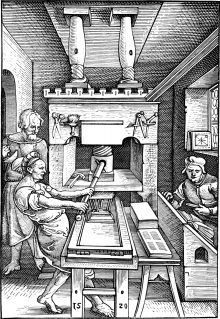
Reading and printing[change | change source]
In the Middle Ages, most artistic, legal, and historical production took place in and around books. Monasteries, churches, universities, and people who could afford them produced and owned books. Books were produced entirely by hand, which is why they were called manuscripts; illuminated manuscripts include hand-colored, drawn, and gilded pictures.
Most books at that time were written in Latin, Greek, and Roman, which was used in the Catholic Church. Only priests and well-educated people read Latin then. People were forbidden by law from translating the Bible into Italian, English, German, French, or other "local" languages.
Around 1440 the first printed books were made in Europe. The printing press made it possible to print copies of large books like the Bible and sell them cheaply. It took 300 calf skins or 100 pig skins to print the Bible. Printers soon began to print everything that they thought was interesting: Ancient Greek and Roman writings, poetry, and plays; stories about the lives of the saints; mathematics textbooks; medical textbooks; Christian stories; erotic stories; books about animals and monsters; maps of the world; and advice to princes about how to rule their people.
Before the invention of the printing press, knowledge had belonged to priests, monasteries and universities. Suddenly many thousands of people, even merchants, could learn far more than they ever could before.
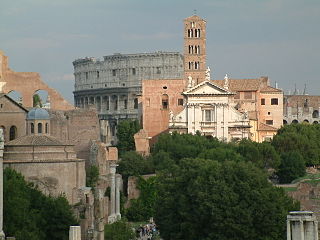
Ancient Roman things[change | change source]
From about 400 B.C. to about 400 AD, Europe experienced a Golden Age. In Ancient Greece and Rome, there were many philosophers, writers, painters, sculptors, architects and mathematicians. Things were beautiful, well-organized and well-run.
However, by the year 1400, the city of Rome was in ruins. Inside the broken walls that had been smashed in 410 AD were the remains of huge temples, sports arenas, public baths, apartment blocks and palaces. Nearly all of them were half-buried and ruined, so they could not be used. Many were pulled down to use as building stone.
Among the ruins of this once-great city, the people of Rome lived in cottages. They still went to church in the huge churches (basilicas) built by the first Christian Emperor, Constantine the Great, in the 4th century. They still held market day in the Ancient Roman market place of Campo dei Fiori ("Field of Flowers").
In 1402, Filippo Brunelleschi and a teenage Donatello came to Rome. They were probably the world's first archaeologists. They were fascinated by everything that they saw. They measured ancient ruined buildings, drew things, and dug around for weeks looking for bits of broken statues and painted pottery that they could put back together. By the time they went back home to Florence, they knew more about Ancient Roman architecture and sculpture than anyone had known for about a thousand years. Brunelleschi became a very famous architect and Donatello became a very famous sculptor.
Cash and politics[change | change source]

The Renaissance really began in the city of Florence. In those days, Italy was not one single country. It was made of many little states, all governed in different ways. These states were constantly making alliances and fighting with each other.
Rome was politically powerful, because Rome had the Pope, the person in control of the Roman Catholic Church. Because of his very great importance as a spiritual leader, most people and most cities did not want to argue with any pope. After a pope died, a new pope was elected. Everyone who was rich and powerful hoped a member of their family would be chosen. It was always a good idea to have several young men in the family trained as priests, just in case. It also helped to be good friends with other rich families. One way to do this was to have lots of daughters and get them to marry rich powerful men from different cities. This was the way that politics worked.
There were other powerful cities in Italy too. Venice had a large and powerful navy. Milan controlled trade with Northern Europe and was very rich. Genoa was also very rich, because it controlled trade with France and Spain. Florence, where many people say the Renaissance started, was another important city.
Florence’s strength did not come from a strong army, a strong fortress, or control over trade. It came from banking. The Medicis were an important banking family. They helped to make Florence a powerful city and the centre of Renaissance learning.
Capture of Constantinople
List of important events of the Renaissance[change | change source]
In art[change | change source]
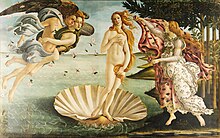
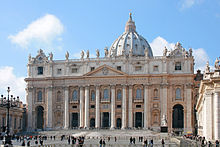

- 1401: Lorenzo Ghiberti wins a competition to create the Florence Baptistry Doors. Over the next 21 years, he creates two famous bronze doors with relief sculptures showing religious scenes.
- 1420s: Masaccio and Masolino paint the Brancacci Chapel in Florence.
- 1440s: Donatello makes the statue of Gattamelata on Horseback in Padua.
- 1470s: Botticelli paints the Birth of Venus in Florence.
- 1490s: Leonardo da Vinci paints The Last Supper and the Mona Lisa in Milan.
- 1508-1512: Michelangelo paints the Sistine Chapel Ceiling in Rome.
In architecture[change | change source]
- 1420: Workers begin to build The Dome of Florence Cathedral, using Brunelleschi's design.
- 1420s: Brunelleschi designs the church of Church of San Lorenzo in Florence.
- 1444: Michelozzo designs the Medici-Riccardi Palace for Cosimo de' Medici.
- 1471: Alberti designs the Church of Sant' Andrea in Mantua.
- 1506: Work begins on the new St. Peter's Basilica in Rome.
- 1550: Palladio designs the Villa Rotunda near Vicenza.
In science and technology[change | change source]
- Early 1300s: The first guns are made.
- 1455: Johannes Gutenberg uses the printing press he invented to create the first printed book in Europe.
- Late 1400s: The quadrant was developed to help sailors find their way at sea.
- 1480s: Leonardo da Vinci studies human anatomy.
- 1550s: Peter Henlein of Nuremberg makes the first watches.
- 1608: Hans Lippershey of Holland makes the first telescope.
- 1618, William Harvey discovered that the heart pumps blood.
In thinking[change | change source]
(See illustration above: Raphael's "School of Athens")
- Early 1300s: Petrarch publishes writings based on the works of St. Augustine and other classical writers.
- Mid 1400s: The Humanist Academy is created to discuss ancient writings and modern ideas. The Medici family supports the academy financially.
- 1511: Desiderius Erasmus publishes In Praise of Folly, which satirizes the traditions of the Catholic Church.
- 1532: Machiavelli publishes The Prince by Machiavelli, which says that people who wish to have political power often do wicked things to get it.


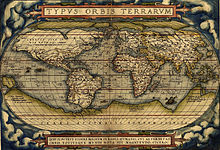
In religion[change | change source]
- 1382: John Wycliffe first translates the Bible from Latin into English. This begins a movement to translate the Bible into many other European languages.
- 1454-1455: Johannes Gutenberg prints his famous Bible. The mass production of Bibles begins.
- 1517: On the door of Wittenberg Castle, Martin Luther posts The Ninety-Five Theses (his ideas about problems in the Church). This is an important event in the Reformation.
- 1534: Henry VIII splits the Church of England from the Roman Catholic Church
- 1545: Pope Paul III calls the Council of Trent so that Catholic leaders can meet and discuss the problems that the Reformation has caused for to the Catholic Church. This is the beginning of the Counter Reformation.
- 1559: John Calvin starts the Geneva Theological Academy to teach people new (Reformation) ideas about Christian faith.
In writing[change | change source]
- Early 1300s: Dante Alighieri writes The Divine Comedy in Italy.
- 1348: Giovanni Boccaccio, an Italian, starts writing a collection of stories called The Decameron.
- 1477: William Caxton publishes The Canterbury Tales, which was written in the 1300s by Geoffrey Chaucer. This is the first important book written in the English language.
- 1532 and 1534: Francois Rabelais writes Pantagruel and Gargantua in France.
- 1550: Giorgio Vasari, an Italian, publishes "Lives of the Great Architects, Painters and Sculptors of Italy".
- 1590-1612: William Shakespeare writes his 37 plays in England.
- 1605 and 1616: Miguel de Cervantes publishes the tale of Don Quixote, Man of La Mancha in Spain.
In exploration[change | change source]
- 1487-1488: Bartholomeu Dias sails down the coast of Africa to the Cape of Good Hope.
- 1492: Christopher Columbus sails from Spain across the Atlantic Ocean to the West Indies.
- 1497-1499: Vasco da Gama sails from Portugal to India by going around Africa.
- 1519-1522: Ferdinand Magellan leads an expedition to sail around the world. The expedition is completed under the command of Juan Sabastian del Cano.
- 1577-1580: Sir Francis Drake completes the second voyage around the world.
Related pages[change | change source]
References[change | change source]
- ↑ "A beginner's guide to Mannerism | Mannerism | Khan Academy". Archived from the original on 2016-04-20. Retrieved 2016-07-26.
- Ilan Rachum, The Renaissance: an Illustrated Encyclopedia, Octopus, ISBN 0-7064-0857-8
- Edmond Wright, Ed., The Medieval and Renaissance World, Chartwell Books, Inc. ISBN 0-89009-264-8
- Margaret Aston, The Fifteenth Century, Tames And Hudson, ISBN 0-500-33009-3
- Denys Hay and John Law, Italy in the Age of the Renaissance, Longman, ISBN 0-582-48358-1
- John T. Paoletti and Gary M. Radke, Art in Renaissance Italy, Laurence King Publishing, (2005), ISBN 1-85669-439-9
Other websites[change | change source]
- Links for Middle School students Archived 2008-06-10 at the Wayback Machine from the Courtenay Middle School Library Collection


 French
French Deutsch
Deutsch